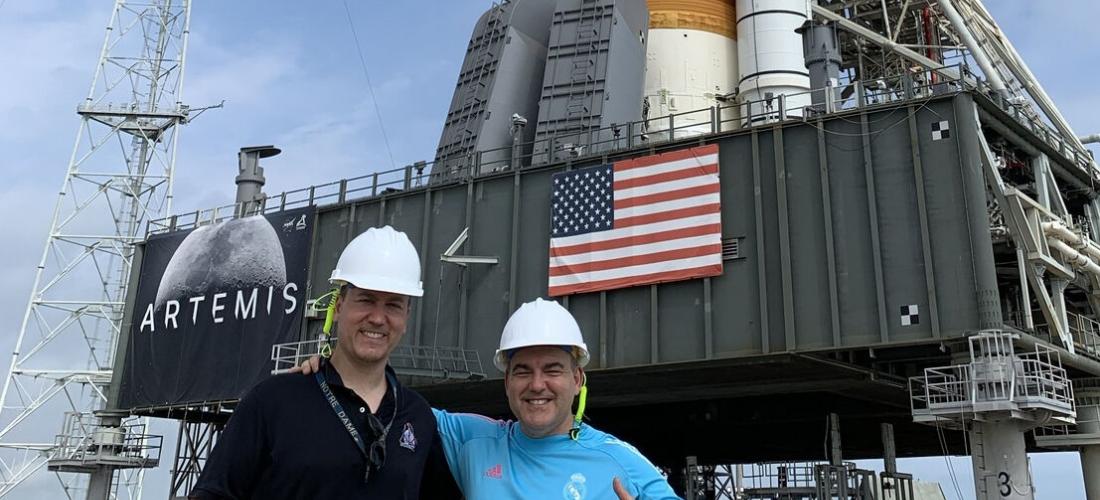NASA engineer Carlos García Galán brings the space race to more than 700 young people at the ETSI
The NASA engineer , Carlos García-Galán , has narrated today at the Higher Technical School of Engineering of the University of Seville , in front of an audience of more than 700 high school and university students, the advances that it has meant for the space race. the Artemis I Mission .
50 years after humans set foot on the Moon for the last time aboard Apollo 17, on November 16, 2022, engineers and scientists members of NASA's Artemis I Mission managed to make a visit with the purpose of continuing to advance in which will be the next challenge: converting this natural satellite into the technological test platform to reach the next objective in the space race, Mars.
Carlos García-Galán is the Head of the Integration Office of the European Service Module (ESM) of the Orion spacecraft at the NASA Glenn Research Center, which circumnavigated the Moon for 26 days. He has also been involved in other facets of the design and integration of the Orion spacecraft and Artemis missions.
During the Artemis I mission, he led the Orion engineering team that supported all operations from launch to return to Earth.
During his speech, García-Galán explained to the young people that NASA hopes to be working on Mars as early as 2030. “During this decade we will be working on the systems and infrastructure to return to the Moon, and in the next in the Lunar base and in the technologies necessary to arrive and live on Mars. The engineers who are now working on Artemis are going to take the first step, but you are the Artemis generation and you will take us to Mars,” stated García-Galán.
The Spanish engineer is currently visiting all the European countries participating in Artemis I to share the results and explain what NASA's next steps will be. This meeting with the ETSi students has been organized by the Ellas Vuelan Alto Association (EVA) , whose main objective is to make female talent visible in the aerospace sector and ensure that women take center stage in this second space race.
In this sense, Irene Rivera , Head of Space at EVA, sent a message to the young attendees to help break the glass ceiling: “in 1969, a group of women, the Mercury 13, were prepared to go to the Moon. They didn't allow it. Today, none of the girls here find limits, to go to the Moon, to Mars or wherever she wants to go!
Likewise, he wanted to emphasize that “it is no longer necessary to be born or study in the United States to work at NASA. It can be done from here, from Seville and from anywhere in Spain. You are part of the #Artemisgeneration! “.
After the conference, a round table began in which top-level professionals participated, such as Jim Geffre , Head of Vehicle Integration of the Orion spacecraft – NASA, Juana Martínez Heredia , Researcher at the Higher Technical School of Engineering of the University of Seville, Silvia De los Santos Trigo, Head of Aerospace Sector at CTA and Technical Assistance Presidency Seville City Ariane, and Sonia Fereres. Researcher at the Joint Research Center – European Commission.
Next, Isabel Pérez Grande, Director of Science, Technology and Innovation of the Spanish Space Agency , was in charge of taking the floor to send an important message to the students present: “Space is exciting. From here I encourage you to consider directing your career towards this field. It is possible to work in space from numerous scientific-technical disciplines that range from the different branches of engineering to sciences such as physics, chemistry, geology or biology, among others.
Andrés Sáez Pérez , Director of the Higher Technical School of Engineering of the University of Seville, was in charge of opening this debate and welcoming the attendees. Sáez Pérez thanked the presence at the ETSi of such prestigious figures within aerospace engineering, highlighting the importance that this type of event has for promoting vocations in future professionals in the sector in general and for attracting female talent in particular. , especially focusing on “the need to offer references in the world of STEM professions both to adolescent girls who have to make the decision of where to direct their studies and their professional future, and to women who in the coming years will join the labor market.”
This day is part of the program of activities on the occasion of World Space Week, which will be held from October 4 to 10, 2023.
